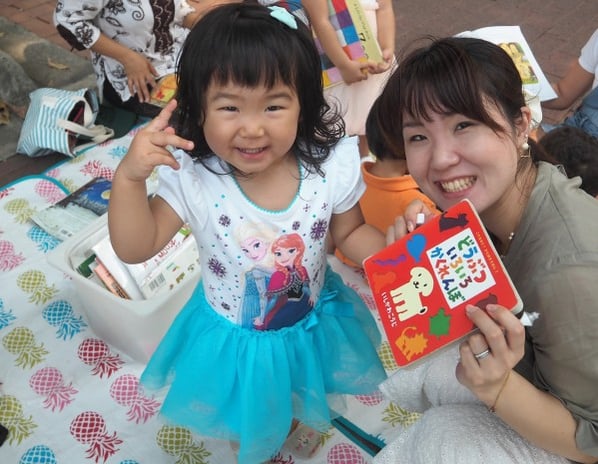
Tina Stephenson-Chin
Previous Executive Director of Pedagogy, Tina oversees Reggio Emilia (Asia) and a range of professional development initiatives. Tina has been an active contributor to popular and academic publications, in Canada and Asia, on a range of behavioral and education issues for the past 10 years. She was previously Senior Lecturer for Middlesex University London and Open University Hong Kong in teacher qualification granting programmes including their Honours B.A. in Early Childhood Studies – the only bachelor’s degree in education from a foreign institution fully-accredited in Hong Kong. She is also a member of the Ontario College of Teachers in Canada and The National College of Teaching and Leadership in the U.K.
I love to read stories to children. I enjoy working with the text, adding emphasis and changing my voice to match the different characters in the stories. Over the years, it has taken a bit of practice to get better at it. But it is all worth it when I look out over a group of children’s faces, captured by the story and listening intently.
Reading is a passion and an ability that is developed over a lifetime - beginning at birth and carrying on throughout our lives. Of course, I do not mean 'start teaching children to read at birth'; learning to read or decoding text is only one aspect of learning to read. Children need to become captivated by the speech used in storytelling and eventually, as they become more word-oriented, they will begin to learn to read and decode text. This process of capturing their interest is the first step and can begin at birth.
I have put together 9 tips which can help to inspire early literacy; these tips are listed in a step-wise manner, starting from the youngest months and proceeding to the school years.
Reading Strategy 1: If you love it, they will too
Firstly, the most important thing children need to acquire is a love of reading. If children love books -- and are being read to -- then I can guarantee they will become avid readers; it is simply a natural extension of the process. Enjoying books naturally leads to interest in text and a desire to read for themselves. The general rule is that parents who enjoy reading have children who enjoy reading too - and in my many years of early childhood practice, I have never seen an exception to that rule.
Parents who love to read can love to read anything. We do not need to pretend to love the greatest works of literature, we merely need to be seen reading from time to time; reading anything will do - newspapers, magazines, picture books – all can be used to instill a love of reading in your child.
Reading Strategy 2: Start early and be consistent
I have been reading actively to my son since he was born, and reading is a natural part of his life. We have had at least one book a day - everyday his whole life. Some books we read over and over, some books we only read once; some books have stories, some are just pictures - but we have enjoyed each and every one. Being together is easy to enjoy: It usually happens in a relaxed environment, usually involves physical contact and always involves talking about the book or the ideas it inspires. All these make it easy to love reading.
Reading Strategy 3: Choose books for the right age level
Books that are too long can be boring. Books with the wrong types of illustrations can scare children. The books you chose are important. Infants like books which can be mouthed and pulled without being ripped to pieces. Toddlers like books about things similar to their everyday experiences –family activities such as going to school, cleaning the house, taking the bus, riding a train, going to restaurants, going shopping. They also like animals, and thus stories about animals doing things like humans and wearing human clothes are usually appealing.
Preschoolers like books which include fantasy and imagination; princesses and superheroes are popular among preschoolers. All children like stories about families doing real everyday things. School-aged children have a well-developed sense of humor and therefore like funny or silly books sometimes.
Reading Strategy 4: Show them how books work
There are conventions to reading which also need to be learned, and so it helps to introduce those ideas from an early age. Turn the book upside down and ask your child “Is this is the right way?” Move your fingers across the text as you read. Point out elements in the illustrations which also appear in the text.
Reading Strategy 5: Introduce the book
Books have authors and illustrators - they are creative works of art and it helps to point out the names of the author and illustrator. Talk about the cover and speculate what the book may be about. Ask questions like, “Do you think the story will be funny? Scary?”
Reading Strategy 6: Point out sight words
Phonics is a useful way to learn new words, but most of the time we sight read. Our brains are excellent at isolating patterns, most of the time it is that patterning of text and the shape of the words that we ‘read’. This ability develops over years of being exposed to text. As your children grow, so will their interest in text. Start by pointing out letters which appear throughout the text, especially at the start of words. Then, as they progress, begin to show them common words which appear throughout the text: “the”, “it”, “I”, “he, “she” – learning to identify those words puts them concretely on the road to reading.
Reading Strategy 7: Switch reading roles
As your child begins to decode text and read sight words, it is a good time to share the role of reading with them - you read one line and they read the next. Or they read a few words, and then you read a few lines. This process encourages them to read along with you and allows them to take pride in showing you what they have learned.
Reading Strategy 8: Use grammar and punctuation
Grammar and punctuation are challenging to learn, and one reason is because they are indistinctly expressed in speech. When you read aloud, make use of the punctuation - pause at commas, and take a deep breath at each full stop; change your voice for text wrapped in quotations. Punctuation marks are like road signs, they tell us how the story goes - and they are only really learned by hearing them being used. Punctuation translates spoken words into written text - it sets cadence, rhythm and mood for the text.
Reading Strategy 9: Don’t stop reading
Lastly, don’t stop reading. As children learn to read, they will like picture books for their own reading; but as they get older and their attention span increases, they will become more interested in books with longer blocks of text about more complex ideas. Books like Diaries of a Wimpy Kid or Charlotte Web will be their choice for reading aloud. These books can be read aloud to the whole family - it may seem a bit old-fashioned but sitting together listening to a book being read aloud is a pleasure for all ages and can make for some great quality time together.
Need ideas on reading and writing projects for the holidays? Click here.


